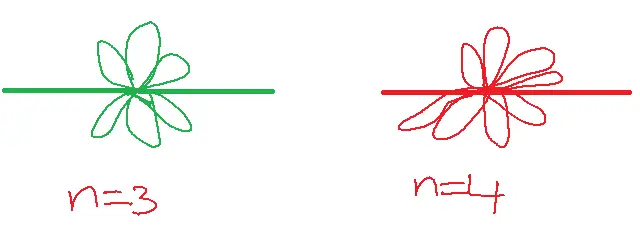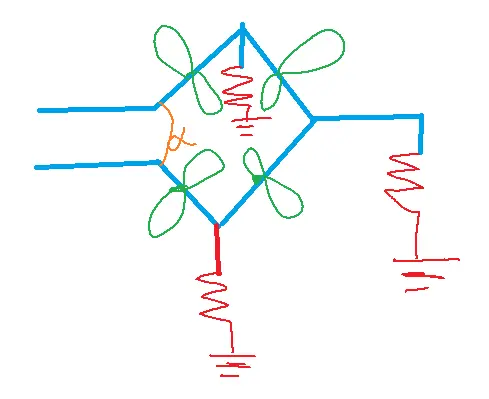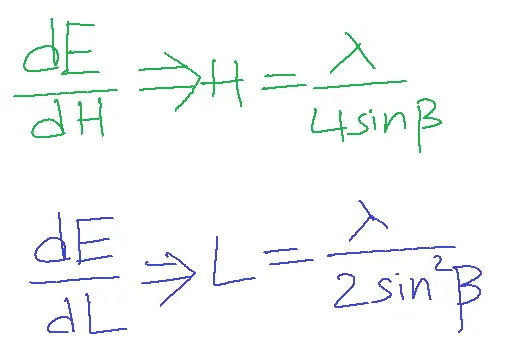- Higher frequencies (3-30 MHz) experience increased attenuation when propagating along the ground. Therefore the horizontal antennas are preferable next to vertical dipoles.
- For these frequencies, ionospheric propagation is more advantageous than ground wave propagation due to its longer reach and ability to overcome obstacles.
- Reflected waves in improperly terminated horizontal antennas create a pattern where radiation travels in both directions. However, Non-resonant radiators, which have no reflected waves, exhibit a pattern with radiation directed in a single direction.
- Types of Non-resonant Radiators:
- 1. Long wire antenna
- 2. V-Antenna
- 3. Inverted V-Antenna
- 4. Rhombic Antenna
Table of Contents
1. Long wire Antenna:
A long wire antenna is a linear antenna whose length is integer multiples of n lambda.
Resonant antenna

The electric field strength of the resonant antenna is given by

For Non-Resonant Antenna:

Physical Length of antenna L=492(n-0.05)/f(MHz) feet
Radiation resistance for long wire
Rr=73+69log10n

Rhombic Antenna:
- A long wire antenna, formed into a rhombus and fed by a uniform transmission line with a characteristic impedance termination, is a specific type of antenna configuration.
- A rhombic antenna is also known as a Diamond Antenna.
- α is known as tilt angle which can control the length of the antenna. Similarly, the length of the wire is increased when we increase the directivity.

- We control the rhombic antenna by adjusting these parameters:
- i. Length of the leg
- ii. Tilt angle(α)
- iii. Termination Impedance
- The angle of the major lobe can be controlled by using the l/lambda value, which means varying length from 2 lambda to 8 lambda. β value changes by 70 degrees to 24 degrees.
In the design of a rhombic antenna, the electric field is given by

The major advantage of the rhombic antenna is two parameters h(height above the ground), and l(length of the antenna) will change the electric field strength.

As length increases, the apex angle decreases.
The rhombic antenna is effective for high-frequency communications and its greatest advantage is that the input impedance and radiation pattern do not change considerably therefore it is replaced.
Advantages of Long Wire Antenna
1. Enhanced DX Reception and Transmission: Long wire antennas are renowned for their capacity for capturing weak signals from distant stations (DX), making them ideal for global communication and chasing rare contacts. They also radiate signals efficiently, increasing your reach.
2. Simplicity and Ease of Construction: Long wire antennas stand out for their simplicity and ease of construction, unlike more complex beam antennas. A functional antenna can be quickly assembled in minutes using only wire, insulators, and a feedline.
3. Cost-Effectiveness: Long wire antennas are a budget-friendly option for hams. The materials are readily available and inexpensive, making them an excellent choice for beginners or those exploring a cost-conscious solution.
4. Directional Capabilities: Although not as directional as yagi antennas, long-wire antennas still exhibit a degree of directionality in their radiation pattern. By adjusting the wire’s orientation, you can favor certain directions for communication, helping to reduce interference and focus your signal.
5. Versatility and Adaptability: Long wire antennas can be easily adapted to different bands and frequencies. With simple adjustments to the length and feedline, you can cover multiple amateur radio bands with a single antenna.
Advantages of Rhombic Antenna:
1. High Gain & Directivity for Long Distance: Rhombic antennas excel in long-distance communication with their focused signal and wide range of usable frequencies.
2. Simple Design & Easy Construction: Despite their effectiveness, rhombic antennas are relatively simple to build and maintain.
3. Ideal for Long-Distance Communication: The horizontal polarization and low-angle radiation of rhombic antennas make them perfect for long-distance communication.
4. Multi-Band Operation: Rhombic antennas offer flexibility, as they can be adapted for use on multiple frequency bands with suitable adjustments.
Disadvantages of Long Wire Antenna and Rhombic Antenna
Wire Antennas
- Limited Bandwidth: Often designed for a specific frequency, making them less versatile.
- Susceptible to Noise: Can pick up electrical noise from surrounding sources.
- Focused reception: Designed to prioritize signal reception from specific directions for optimal performance.
- Efficiency Issues: Lower efficiency compared to other antenna types.
- Physical Size: Can be large and cumbersome, requiring substantial space for installation.
Rhombic Antennas
- Large Footprint: Requires a significant amount of land for installation due to its size.
- Power Loss: Terminating the resistor at the end of the antenna leads to power loss.
- Complex Design and Tuning: Can be challenging to achieve optimal performance through proper design and tuning.
- Susceptible to Environmental Factors: Wind, rain, and other elements can affect performance.
- Limited Elevation Angle: Primarily designed for low-angle radiation, limiting its use for skywave communication.
FAQs related to the topic
Q1. What are non-resonant antennas, and how do they differ from resonant ones?
- Non-resonant antennas, like long wires and rhombic antennas, operate over a wide range of frequencies without needing to be specifically tuned to a particular frequency.
- In contrast, resonant antennas are optimized for a specific frequency, delivering superior gain at that particular frequency.
Q2. What are the best applications for wire and rhombic antennas as non-resonant radiators?
Non-resonant wire and rhombic antennas are well-suited for applications that require:
- Multi-band operation: Their wide bandwidth allows them to operate on multiple frequencies.
- Long-distance communication: Rhombic antennas, in particular, are known for their excellent long-distance communication capabilities.
- HF and shortwave broadcasting: They are often used for transmitting in the HF and shortwave bands.
Q3. How do I choose the right wire or rhombic antenna for my needs?
Choosing the right antenna depends on several factors, including:
- Frequency range: Consider the frequencies you want to transmit or receive.
- Available space: Determine the amount of space you have for installation.
- Budget: Factor in the cost of the antenna and any associated materials.
- Directivity requirements: Decide if you need an antenna with directional capabilities.
- Experience level: Consider your level of experience with antenna construction and installation.
Q4. How do I properly install and maintain a wire or rhombic antenna?
Proper installation and maintenance are crucial for optimal performance. Here are some tips:
- Wire Antennas: Ensure adequate clearance from obstacles, use sturdy supports and regularly check for damage or corrosion.
- Rhombic Antennas: Choose a suitable location with enough space, ensure proper tensioning of wires, and regularly inspect for loose connections or deterioration.
Q5. Can I use a wire or rhombic antenna for both transmitting and receiving?
Yes, both wire and rhombic antennas can be used for both transmitting and receiving signals. Their non-resonant nature allows them to work effectively across a wide range of frequencies, making them versatile for various communication modes.
Q6. Are there any safety precautions I should take when using wire or rhombic antennas?
Yes, safety is paramount when working with antennas:
- Avoid High-Voltage Lines: Ensure antennas are installed far away from power lines to prevent electrical hazards.
- Grounding: Properly ground the antenna system to protect against lightning strikes and electrical surges.
RF Safety: Be aware of radio frequency (RF) exposure limits and take precautions to minimize exposure when transmitting at high power levels.
